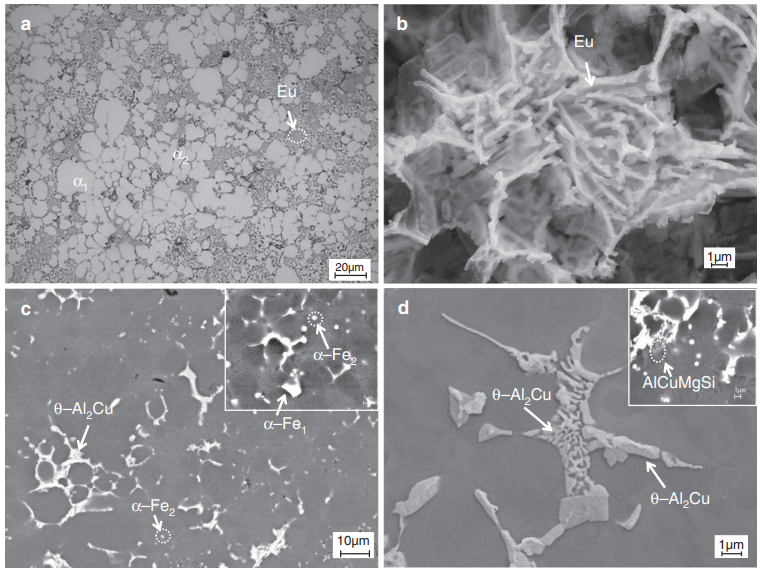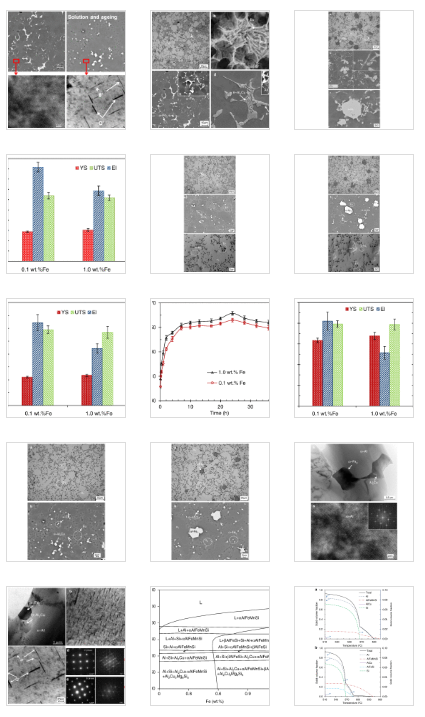HailinYangabShouxunJiaZhongyunFanaShow moreAdd to MendeleyShareCite
https://doi.org/10.1016/j.matdes.2015.07.074Get rights and content
Highlights
• Solution and ageing significantly improve the tensile strength of die-cast Al–Si–Cu alloy.
• Low Fe is necessary for improving the ductility in the solution and aged alloy.
• Cu-rich phase is dissolved during solutionising of die-cast Al–Si–Cu alloy.
• θ′ and Q′ precipitates co-exist in die-cast Al–Si–Cu alloy for strengthening.
• Solution and ageing do not alter the size and morphology of αAlFeMnSi phase.
Abstract
The effect of solution and ageing heat treatment on the microstructure and mechanical properties of the die-cast Al–9 wt.%Si–3.5 wt.%Cu alloys containing 0.1–1.0 wt.% Fe was investigated. The results showed that the dendritic primary α-Al phase was varied from 20 to 100 μm in size and the globular α-Al grains were smaller than 10 μm in size. The Fe-rich intermetallics exhibited coarse compact or star-like shapes with the sizes from 10 to 20 μm and the fine compact particles at an average size of 0.75 μm. The solution treatment of the alloys could be achieved in a short period of time, typically 30 min at 510 °C, which dissolved the Cu-rich intermetallics into the primary α-Al phase and spheroidised the eutectic Si phase. During the subsequent ageing treatment, numerous fine precipitates of θ′ and Q′ phases were formed to provide effective strengthening to the α-Al phase, significantly improving the mechanical properties. Therefore, Fe content in the die-cast Al–Si–Cu alloys needs to be controlled at a low level in order to obtain the improved ductility and strength under solution and aged condition.
0.1~1.0wt.% Fe를 함유한 다이캐스트 Al-9wt.%Si-3.5wt.%Cu 합금의 미세 구조 및 기계적 특성에 대한 용체화 및 시효 열처리의 영향을 조사했습니다. 그 결과 수지상 1차 α-Al 상은 크기가 20~100μm로 다양하고 구형 α-Al 입자의 크기는 10μm 미만인 것으로 나타났습니다. Fe가 풍부한 금속간 화합물은 크기가 10~20μm인 조대 조밀하거나 별과 같은 모양과 평균 크기 0.75μm의 미세 조밀 입자를 나타냈습니다. 합금의 용체화 처리는 일반적으로 510°C에서 30분의 짧은 시간 내에 달성될 수 있으며, 이는 Cu가 풍부한 금속간 화합물을 기본 α-Al 상으로 용해하고 공융 Si 상을 구형화합니다. 후속 시효 처리 동안 θ' 및 Q' 상의 수많은 미세 석출물이 형성되어 α-Al 상에 효과적인 강화를 제공하여 기계적 특성을 크게 향상시켰다. 따라서 다이캐스트 Al-Si-Cu 합금의 Fe 함량은 용체화 및 시효 조건에서 향상된 연성 및 강도를 얻기 위해 낮은 수준으로 제어되어야 합니다.
Graphical abstract


Keywords
Alloys
Castings
Microstructure
Mechanical properties
Solutionisation
Ageing
References
[1] B. Upton, Pressure Diecasting, Pergamon Press Ltd., Oxford, UK, 1982.
[2] S. Ji, D. Watson, Z. Fan, M. White, Development of a super ductile diecast Al–Mg–Si
alloy, Mater. Sci. Eng. A 556 (2012) 824–833.
[3] Office for low emission vehicle, Driving the Future Today —A Strategy for Ultralow
Emission Vehicles in the UK, https://www.gov.uk/government/uploads/system/uploads/attachment_data/file/239317/ultra-low-emission-vehicle-strategy.
pdf September 2013.
[4] V. Kevorkijan, Challenges and advanced of recycling wrought aluminium alloys from
lower grade of metallurgically clean scrap, Mater. Technol. (MTAEC9) 47 (2013)
13–23.
[5] S.K. Das, Designing aluminium alloys for a recycling friendly world, Mater. Sci.
Forum 519–521 (2006) 1239–1244.
[6] S. Ji, W. Yang, F. Gao, D. Watson, Z. Fan, Effect of iron on the microstructure and mechanical property of Al–Mg–Si–Mn and Al–Mg–Si die-cast alloys, Mater. Sci. Eng. A
564 (2013) 130–139.
[7] H. Yang, D. Watson, Y. Wang, S. Ji, Effect of nickel on the microstructure and mechanical property of die-cast Al–Mg–Si–Mn alloy, J. Mater. Sci. 49 (2014)
8412–8422.
[8] X. Cao, J. Campbell, Precipitation of primary intermetallic compounds in liquid Al
11.5Si 0.4Mgalloy, Int. J. Cast Met. Res. 13 (2000) 175–184.
[9] S. Ji, Y. Wang, D. Watson, Z. Fan, Microstructural evolution and solidification behaviour of Al–Mg–Si alloy in high-pressure die casting, Metall. Mater. Trans. A 44
(2013) 3185–3197.
[10] P. Skjerpe, Intermetallic phases formed during DC-casting of an Al–0.25 Wt Pct Fe–
0.13 Wt Pct Si alloy, Metall. Mater. Trans. A 18A (1987) 189–200.
[11] S. Shivkumar, L. Wang, D. Apelian, Molten metal processing of advanced cast aluminium alloys, JOM 43 (1991) 26–32.
[12] J.R. Davis, Aluminium and aluminium alloys, ASM Speciality Handbook, ASM International, OH, USA, 1993.
[13] D.M. Stefanscu, J.R. Davis, J.D. Destefani (Eds.), ASM Metals Handbook, 9th edn, Casting, Metals Park, vol. 15, ASM International, OH, USA, 1988.
[14] A.A. Luo, A.K. Sachdev, B.R. Powell, Advanced casting technologies for lightweight
automotive applications, China Foundry 7 (2010) 463–469.
[15] European Aluminium Association, The Aluminium Automotive Manual, Version
2002, http://www.alueurope.eu/wp-content/uploads/2012/01/AAM-Manufacturing-1-Casting-methods.pdf.
[16] A.M.A. Mohamed, F.H. Samuel, A Review on the Heat Treatment of Al–Si–Cu/Mg
Casting Alloys, 2012.http://dx.doi.org/10.5772/79832.
[17] R.N. Lumley, R.G. O'Donnell, D.R. Gunasegaram, M. Givord, Heat treatment of highpressure die castings, Metall. Mater. Trans. A 38 (2007) 2564–2574.
[18] E. Sjölander, S. Seifeddine, Optimisation of solution treatment of cast Al–Si–Cu alloys, Mater. Des. 31 (2010) S44–S49.
[19] Y.J. Li, S. Brusethaug, A. Olsen, Influence of Cu on the mechanical properties and precipitation behavior of AlSi7Mg0.5 alloy during aging treatment, Scripta Mater. 54
(2006) 99–103.
[20] C. Cayron, L. Sagalowicz, O. Beffort, P.A. Buffat, Structural phase transition in AlCu–
Mg–Si alloys by transmission electron microscopy study on an Al–4 wt% Cu–
1 wt% Mg–Ag alloy reinforced by SiC particles, Phil. Mag. A 79 (1999) 2833–2851.
[21] L. Backerud, G. Chai, J. Tamminen, Solidification characteristics of aluminium alloys,
Foundry Alloys 2 (1990) 71–84.
[22] A. Couture, Iron in aluminium casting alloys—a literature survey, AFS Int. Cast Met. J.
6 (1981) 9–17.
[23] M. Aravind, P. Yu, M.Y. Yau, H.L. Dickon Ng, Formation of Al2Cu and AlCu intermetallics in Al(Cu) alloy matrix composites by reaction sintering, Mater. Sci. Eng. A 380
(2004) 384–393.
[24] A.M. Samuel, J. Gauthier, F.H. Samuel, Microstructural aspects of the dissolution and
melting of Al2Cu phase in Al–Si alloys during solution heat treatment, Metall. Mater.
Trans. A 27A (1996) 1785–1798.
[25] J.D. Wilde, L. Froyen, S. Rex, Coupled two-phase [α(Al) + θ(Al2Cu)] planar growth
and destabilisation along the univariant eutectic reaction in Al–Cu–Ag alloys, Scripta
Mater. 51 (2004) 533–538.
[26] S.C. Wang, M.J. Starink, Precipitates and intermetallic phases in precipitation hardening Al–Cu–Mg–(Li) based alloys, Int. Mater. Rev. 50 (2005) 193–215.
[27] F.J. Tavitas-Medrano, A.M.A. Mohamed, J.E. Gruzleski, F.H. Samuel, H.W. Doty, Precipitation-hardening in cast Al–Si–Cu–Mg alloys, J. Mater. Sci. 45 (2010) 641–651.
[28] S.C. Weakley-Bolin, W. Donlon, C. Wolverton, J.W. Jones, J.E. Allison, Modelling the
age-hardening behaviour of Al–Si–Cu alloys, Metall. Mater. Trans. A 35A (2004)
2407–2412.
[29] C. Wolverton, Crystal structure and stability of complex precipitate phases in Al–Cu–
Mg–(Si) and Al–Zn–Mg alloys, Acta Mater. 49 (2001) 3129–3142.
[30] W.F. Miao, D.E. Laughlin, Effects of Cu content and pre-aging on precipitation characteristics in aluminium alloy 6022, Metall. Mater. Trans. A 31A (2000) 361–371.
[31] A. Perovic, D.D. Perovic, G.C. Weatherly, D.J. Lloyd, Precipitation in aluminium alloys
AA6111 and AA6016, Scripta Mater. 41 (1999) 703–708.
Cited by (65)
- Significant hardness improvement of a low-density Al-Si-Mg-Li-Fe alloy through laser-aging surface treatment2022, Materials Today CommunicationsShow abstract
- Enhanced mechanical properties and thermal conductivity of high-pressure die-cast AlMg6Si2MnZr alloy by controlling the externally solidified crystals2022, Journal of Materials Processing TechnologyShow abstract
- Effects of Ni content on microstructure and wear behavior of Al–13Si–3Cu–1Mg-xNi-0.6Fe-0.6Mn alloys2022, WearShow abstract
- Making sustainable aluminum by recycling scrap: The science of “dirty” alloys2022, Progress in Materials ScienceShow abstract
- Microstructure-strength correlations in Al-Si-Cu alloys micro-alloyed with Zr2022, MaterialiaShow abstract
- Micro-alloying effects of Mn and Zr on the evolution of ageing precipitates and high temperature strength of Al-11.5Si–4Cu alloy after a long-time heat exposure2021, Materials Science and Engineering AShow abstract